Maintenance of Leave Records:
Approved leave applications received from departments are entered in a leave register and the lower portion of the leave application showing the balance of leave is sent to the employee. Leave records for all executive staffs are maintained by the HRD.
Financial Assistance Scheme:
Priorities for Loan against Salary:
- Medical emergencies for spouse or children
- Death of spouse or children
- Medical emergencies of other dependents
- Death of other dependents
- Rental advance
- Own marriage
- Marriage of siblings
- Education
- Other requirements
Eligibility and Limits:
Salary Advance:
The management always discourages to take loan against salary advance but due to emergencies, usually one month’s average gross salary is given as advance. However, on the extreme emergency, a maximum of two month’s salary can be given as advance.
Repayment of Loan:
1 month’s grace period is given to the employee before the repayment starts. The employee, through automatic deductions by the accounts & Finance department from his/her pay cheque, makes the payment.
Guidelines for Repayments:
– If financial situation permits, the employee is asked to pay the money back with six equal monthly payments
– If the amount of loan is large and the repayment imposes hardship on the employee, it may be considered to extend the repayment schedule to a maximum of 12 equal installments. In such cases, the department head must recommend the Accounts dept. to do so.
Procedures to apply:
The employee completes a loan application form and upon receiving an approval from the department head, submits to the HRD. The HRD personnel review the application, discuss with the employee, if necessary, and let the employee know about the result. At the time of processing the loan request, the HRD identifies the repayment agreement discussing with the employee.
Following is the guideline for loan/advance approval:
| Loan Amount (Tk) | Approval Authority |
| </= 1,00,000.00 | MD |
| > 2,00,000.00 | Chairman |
PERFORMANCE MANAGEMENT AND APPRAISAL
Performance Management:
The annual appraisal of an employee should never be a surprise at the time of review period. The responsibility of the position and its organizational relationship must be made clear to the incumbent when s/he is recruited. It is also vital that the employee is periodically informed of hoe s/he is performing.
Though the development of an individual is jointly owned by the supervising authority and the employee, the immediate supervisor is responsible for facilitating the integration of an employee to his/her work at the time of taking up his/her duties as well as for the management of subsequent development needs of the employee for continuous improvement. The following are some of the responsibilities of immediate supervisor and the HRD for employee integration:
– Provide him/her with a written job description and the organizational relationship of the position. Explain the job duties thoroughly.
– Give a briefing on company policies, procedures, Job-related systems, and its long/short term goals (provide any related written documents).
– Introduce the employee with the key individuals that s/he has to interact on a regular basis. Also, inform all department personnel about his/her joining.
– Attach the new employee with the individual s/he is going to be trained by, if the trainer is other than the immediate supervisor.
Training and development is a continuous process. During and even after the probationary period, employees should have specific development plans based on their development need. It is recommended that each employee have a development plan for a period of every 1 year. To manage performance and to review employee’s development, immediate supervisors are advised to conduct one-to-one meetings every 6 to 8 weeks. The following are some suggested agenda items for the one-to-one meetings:
– Review progress/accomplishments against the agreed Development Plan. Add new action plans, if required.
– Check difficulties and help in removing barriers.
– Give and receive feedback to improve joint productivity.
The progress or accomplishments along with the summary of the discussions are to be documented by the immediate supervisor. It is also advised to keep a separate file for each employee in their department containing performance evaluations and one-to-one meeting notes. These notes can later be utilized for performance evaluation.
Overall Performance Appraisals for Executives
Appraisal is done for all the employees who have passed the Probationary Review and who have been in the organization for at least 6 months in the appraisal year.
Annual Performance Evaluation:
Performance of all employees is appraised annually at the end of each calendar year. This process is initiated by the HRD by sending the following to each of the departments that would go through the appraisal process:
– Copies of Overall Performance Appraisal Form, F012
– Copies of Department Appraisal Summery Form, F013
– Copies of Employee Development Plan Form, F014
The individual copies of Overall Performance Appraisal Form (F012) containing key information like name, employee code, date of joining, designation, last promotion, department, section, and business unit, will be completed by the HRD.
Though the primary responsibility of sending out the Appraisal Forms to the departments lie on the HRD, it is a joint responsibility of both HRD and concerned department to ensure that all necessary forms are in hand (of the supervisors) on time to start and finish the appraisal process within the stipulated time frame defined by the management.
Once the appraisal documents are received from the HRD, the appraisal process starts in each department. The immediate supervisor of the employee is the primary appraiser. Before evaluation, the appraiser may discuss with other key partners for soliciting feedback on the employee’s performance. In the case of an employee who has a dotted line reporting supervisor, the evaluation should be done by joint consultation of both the supervisors but the primary responsibility of completing the performance appraisal lie on the direct supervisor.
The following are the steps for completing the annual performance evaluation:
Step 1 (a)
On the Overall Performance Appraisal Form (F012), Assessment Criteria for evaluation are noted on the left most column. These are also grouped as buckets of specific concentrations such as On the Job Performance, Initiative/Drive for Results, Dependability, Teamwork/ Peer Relation and Personality. The employee will first do his/her self-assessment in column B. The appraiser will then sits with the employee and go through the section once again in column C that will be considered as final. Both the employee and the appraiser must follow the “Scalar Definition” outlined in this form while scoring against each performance criteria.
The next column is the ‘Weight’ that is assigned to each ‘Assessment Criteria’ based on the importance given to it. Total weight sums up to 100. The ‘Scores Obtained’ (Column D) is a product between the ‘Weight’ (Column A) and the score that is finally given by the appraiser (Column C).
The ‘Score Obtained’ (Column D) is then added, and the total goes to the bottom where it says ‘Score Obtained out of 1000’. This is the maximum score an individual can obtain out of 1000. Divide this score by 100 and put the number on the row right below in order to get a ‘Score Out of 10’.
At this point, both the Employee and the Appraiser must sign in the form with comments if any.
Step 1(b)
During the individual evaluation, both the Employee and the Appraiser will construct jointly an “Employee Development Plan” F014 based on concerned employee’s past year performance, career plan and/or any other area relevant to the employee’s scope of work. Generally, an “Employee Development Plan” (F014) should be constructed for a period of one year. It is important to note that; Employee’s Development Plan also needs to be identified based on the priorities giving precedence to ‘business needs, then ‘team needs’, and finally ‘individual needs’.
Step 2
Once the appraiser completes the evaluation of all the employees under him/her by completing the Overall Performance Appraisal Form, a ‘Department Appraisal Summery Form’ (F013) is to be field in. In the Department Appraisal Summery Form, all the employees must be listed in descending order based on the scores they have obtained. The appraiser may use more than one page if necessary to accommodate all of his/her employees.
At the bottom of this form, the department head is advised to list down the promotions if any s/he is recommending for his/her employees.
At this point, the appraiser sits with the reviewing manager/ head of the department to review Department Appraisal Summery Form as well as Employee Development Plan Form. The head of the department/reviewing manager reviews the appraisal for accuracy and fairness. As of this point, ‘Department Appraisal Summery Form’ as well as ‘Employee Development Plan Form’ is only wish list. Decisions on all promotions are to be made by the Appraisal Review Board (ARB) at the time of their review with/without consultation with the appraiser or head of the department.
Step 3
At this step, the Reviewing manager / Head of the department compiles all the relevant Performance Appraisal Forms and forward to the HRD all the original copies of the following documents in an envelope marking as “Confidential”.
Evaluation Boundary Conditions
In an organization, employee performance follows a ‘Norman Distribution’. In order to promote a competitive environment and nurturing for an atmosphere where continuous improvement happens, an organization’s performance rating must reflect a Normal Distribution. To match with the above philosophy closely, each cluster or ranking group will have to be maintained the following way:
| Performance Rating | Population % |
| Outstanding | Maximum 20% of the population |
| Improvement Required and Poor | Maximum 20% of the population |
| Successful and Average | The balanced percentage of the population |
The people who are in the category of “Improvement Required” or “Poor”, the appraiser must have a realistic plan as an “Employee Development Plan” to improve their performance in their low scoring areas, so the individual can become a successful performer within a short time.
Annual Merit Increase/ Promotion and Approvals:
After receiving all the appraisal forms, the HRD will prepare department and company wise Performance Evaluation Summaries, and forward it to the ARB. The board will be constituted with four members committee comprising of Chairman, Managing Director and Manager, HRD. The board will be the sole authority for reviewing and approving of all recommendations and the contesting appraisals.
As a general guidance, promotions of employees who have not been in their present grade for at least two years are to be considered as special cases and therefore require a mandatory review and approval by the ARB. While considering the cases of accelerated promotions and/or exceptionally high increments, the board keeps in mind the effect of such promotions or increments that are likely to have on employees’ morale across the board.
As soon as the Chairman of the company declares the “Increment Schedule” for the year, the HRD will prepare an appraisal tabulation sheet where individual increments will be tagged to employee’s performance rating. The detail tabulation sheet has to be endorsed by both Chairman and Managing Director, and the summery by the Chairman of the company.
Individual letters will then be issued to all employees informing them of the Increments/Promotions that have been awarded to them. These letters are signed as follows:
– For Executives below GM – by the GM, HRD
– For GM – by Chairman / Managing Director
Contesting an Appraisal:
The appraisal system is designed in such a way that it provides a clear view of an individual’s contribution to the company, eliminating any biased treatment. Yet it is possible to have a situation where an appraisal was not accurate due to various reasons, such as employee did not provide required information to highlight his/her performance; the appraiser did not make clear notes of the employee’s accomplishments, etc. Texeurop (BD) Ltd encourages an environment where people can express their opinion if they feel they are being unfairly treated. Upon receiving the result of the annual appraisal, if an employee feels that s/he has been unfairly treated, for example, the rating is incorrect or s/he did not receive the promotion that s/he deserved, etc. then the employee may contest the appraisal.
A contest against an appraisal does not mean that the appraisal done on the employee is incorrect; it only means that the employee’s view of his/her performance is different from that of his/her appraiser. In such case, a written application explaining the reasons for the contest should be forwarded to the GM HRD within two weeks after the appraisal results had been communicated to the employee.
The GM HRD will collect all applications for contests and arrange for an Appraisal Review Board, having the department heads of the contesting employees in the meeting. The members of the committee, along with the department heads would then re-evaluate the contests and decide on the course of actions.
HRD then sends a written decision to contesting employees within four weeks from the date the letter of contest was received.
Appraisal Schedule:
The following is a timetable that can be used as a guideline for communicating and completing the annual appraisals:
| What | Who | Timeline / Time Allocation |
Announcement of the appraisal and distribution of forms | HRD | By December the 7th |
Complete all appraisals (Step 1 to 3) | All appraisers and department heads | By December the 21st (2 weeks) |
Declaration of increment schedule by Chairman for the appraisal year | HRD | By December the 21st |
Finalize increments and promotions; get necessary approvals | Appraisal Review Board | January the 7th |
Results to be informed to the employees | HRD | January the 21st |
Increments and Promotions effective date | N/A | Increment – January the 1st Promotions- Effective on the appraisal communication date |
TRAINING & DEVELOPMENT:
Towards continuous improvement, Texeurop (BD) Ltd is fostering training throughout the organizations within. Currently various units are conducting training differently but an effort is in progress for conducting training in an organized fashion.
The HRD under Texeurop (BD) Ltd is currently working with one by one to identify all job tasks to be trained in order to introduce a formal training system where identified trainers will be training all individuals and certify them as trained workers at a particular level.
Training & Development for Executives:
Currently, the immediate supervisor identifies training need during regular one-to-one meeting conversations. For most of the technical developments, the in-house training is considered. If any identified technical training cannot be conducted in-house, the training need is forwarded to the department head for his/her attention. The department head co-ordinates with the Training Department or other sources to seek training from outside source. For managerial or people skills’ training, the department head requests the Training Department for the specific training. Training department identifies if the training can be provided by the resources inside, or else seeks training from other training organizations.
SWOT ANALYSIS:
Strengths:
- Large investment in Recruitment and Selection program in the company.
- A large number of experienced employee.
- It has well reputation in the market.
Weaknesses:
- Centralized control over the employees.
- Lack of coordination among different sections.
- Shortage of work force at HRD.
- Most of the employees are overburdened with work and need to stay extra hours at office forbidding them to spend enough time with family and self that leads through individual unhappiness to job dissatisfaction.
- Lack of organizational commitment among the employees.
- Lack of concentration in retaining experienced and highly deserving employees.
Opportunities:
- Texeurop (BD) Ltd enjoys the respect of being one of the market leaders in RMG sector.
- Diversification strategy allow Texeurop (BD) Ltd the opportunity of dividing the risk of business among all of its business units.
- Government support for the development of RMG sector.
- Availability of trained employees.
Threats:
- At present, the company is dealing with too many projects at a time, which put forward the threat of losing control over its current operations as financial management became tough.
- Business is highly competitive.
- High rate of employee turnover.
- Labour unrest.
MOTIVATIONAL FACTORS:
Motivational factors those activate the employees to work effectively & efficiently within the organization are:
- During the interview almost all employees within the organization found very loyal to their managing director. They are highly proud of him. All of them, stated that he is highly educated, considering minded, efficient ad effective and also very honest to his work and employees which is very rare in our country.
- It is also found that an acceptable promotion system is existed in the management. The person in the both who are efficient and effective they are getting first priority to get promotion in the management.
- Interpersonal relationship among the management and employees found highly reasonable. Owners behave friendly with management and other employees.
- Freedom of work of any individual found very satisfactory in the Texeurop (BD) Ltd. Most of the management personnel stated that it is the main factor to work nicely in the factory. It actually brings mental happiness to work effectively within the organization.
- It is also found that Texeurop (BD) Ltd provides nice work environment to their employees. Texeurop (BD) Ltd has decorated reasonable office space for the management and also reasonable workspace with the quality equipment for the workers.
- Almost all employees are satisfied on the salary given by Texeurop (BD) Ltd. Most of the workers stated that the salary given by Texeurop (BD) Ltd is reasonable. It is also found that in case of any stuck-up situation Texeurop (BD) Ltd continued stability for paying salary to their employees.
- Texeurop (BD) Ltd is given more priority to the random up ward-downward communication. It is the actual way to find out any problem and solve it quickly. Management communicates more effectively with the gross level.
- Texeurop (BD) Ltd organizes yearly picnic to motivate their employees.
- Texeurop (BD) Ltd provides yearly increment with the salary to the workers.
- Texeurop (BD) Ltd recognizes personal life of any individual. In case of any need Texeurop (BD) Ltd allows to maintain it.
The actual situations of motivation have been found out in the organization by following analysis. These analyses have been prepared from cross tabulation and frequency distribution.
REVIEW OF ANSWERS OF QUESTIONIERS:
- Do you think the recruitment and selection process used in your position was appropriate?
Table. 4.1 Response on recruitment and selection process
| Status | Managerial | % | Skilled Labor | % | Unskilled | % | Others | % |
| Poor | ||||||||
| Fair | 4 | 14% | ||||||
| Good | 14 | 48% | 7 | 17% | 3 | 14% | ||
| Very Good | 11 | 38% | 35 | 83% | 18 | 86% | 2 | 100% |
| Excellent | ||||||||
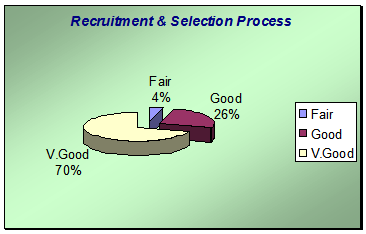
Fig. Graph of response on recruitment and selection process
Analysis: Both the management and workers are satisfied on recruitment and selection process.
- Are you satisfied with the current working hour?
Table 4.2 Response on current working hour
| Status | Managerial | % | Skilled Labor | % | Unskilled | % | Others | % |
| Yes | 15 | 52% | 35 | 83% | 18 | 86% | 2 | 100% |
| No | 14 | 48% | 7 | 17% | 3 | 14% | ||
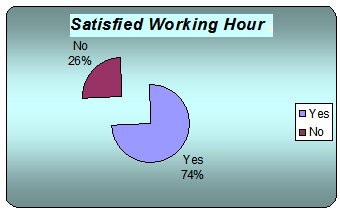
Fig. Graph of response on current working hour
Analysis: Management is not highly satisfied with the current working hour. 48% of employees in management are dissatisfied with the existing working hour. On the other hand workers are satisfied due to overtime payment.
- if Yes, then
Table 4.3 Response on suggested working hour
| Status | Managerial | % | Skilled Labor | % | Unskilled | % | Others | % |
| 7.00-2.30 | ||||||||
| 8.00-4.00 | ||||||||
| 9.00-5.00 | 9 | 64% | 7 | 100% | 2 | 67% | 2 | 100% |
| Fixed hour | 5 | 36% | 1 | 33% |
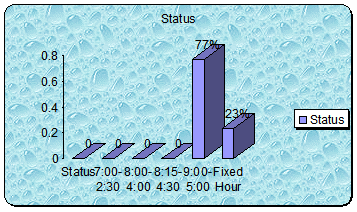
Fig. Graph of response on suggested working hour
Analysis: 64% employees in the management needed the working time from 9:00-5:00. Through the workers are satisfied on current working hour but they will be more happy if applied from 9:00-5:00.
- Your operational relationship with others in your department?
Table 4.4 Response on operational relationship
| Status | Managerial | % | Skilled Labor | % | Unskilled | % | Others | % |
| Poor | ||||||||
| Fair | 7 | 24% | ||||||
| Good | 26 | 62% | 6 | 29% | ||||
| Very Good | 18 | 62% | 16 | 38% | 15 | 71% | 2 | 100% |
| Excellent | 4 | 14% | ||||||
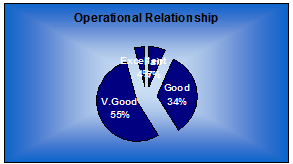
Fig. Graph of response on operational relationship
Analysis: In the field of operational relationship no major deficiency is noticed.
- Is your job properly evaluated by the Management?
Table 4.5 Response on job evaluation system
| Status | Managerial | % | Skilled Labor | % | Unskilled | % | Others | % |
| Yes | 29 | 100% | 42 | 100% | 21 | 100% | 2 | 100% |
| No |

Fig. Graph of response on job evaluation system
bvAnalysis: 100% of both management and workers are satisfied on job evaluation system.
- Do you think the authority should enlarge the opportunities for new comers or they should keep on improving the existing work force?
Table. 4.6 Response on improving the existing work force
| Status | Managerial | % | Skilled Labor | % | Unskilled | % | Others | % |
| New Comers | 9 | 31% | 10 | 24% | 3 | 14% | 1 | 50% |
| Existing work force | 20 | 69% | 32 | 76% | 18 | 86% | 1 | 50% |
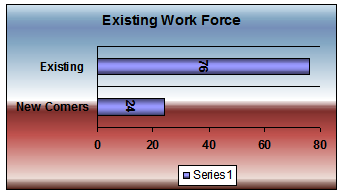
Fig. Graph of response on improving the existing work force
Analysis: Majority in the both sides are interested on improving the existing work force.
- Are the facilities in your position adequate?
Table 4.7 Response on facilities given by the organization
| Status | Managerial | % | Skilled Labor | % | Unskilled | % | Others | % |
| Poor | ||||||||
| Fair | 17 | 7% | ||||||
| Good | 10 | 34% | 10 | 24% | 3 | 14% | 1 | 50% |
| Very Good | 2 | 7% | 32 | 76% | 18 | 86% | 1 | 50% |
| Excellent | ||||||||
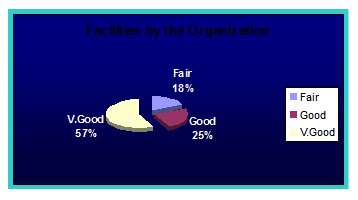
Fig. Graph of response on facilities given by the organization
Analysis: 59% employees in the management are not highly satisfied regarding the facilities given by the organization
- Does fear play any role as a drive for you to work harder?
Table 4.8 Response on role of fear
| Status | Managerial | % | Skilled Labor | % | Unskilled | % | Others | % |
| Yes | 29 | 100% | 42 | 100% | 14 | 67% | 2 | 100% |
| No | 7 | 33% | ||||||
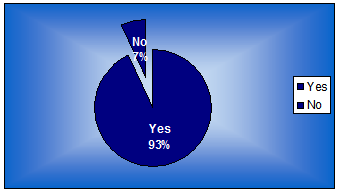
Fig. Graph of response on role of fear
Analysis: 100% employees in the management, skilled & other workers are morally very strong to take any responsibility. But 33% of unskilled worker are not that much strong to take any responsibly.
- if No,
Table 4.9 Response on responsibility
| Status | Managerial | % | Skilled Labor | % | Unskilled | % | Others | % |
| Losing job | 4 | 57% | ||||||
| Promotion | ||||||||
| Reputation | ||||||||
| Reduction | 3 | 43% | ||||||
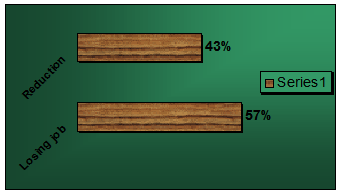
Fig. Graph of response on responsibility
Analysis: Unskilled employees, 57% who are earned to take any responsibility among them 57% marked on “Loosing job and 43% marked on reduction of salary and other benefits”.
- How much confidence do you have on your superior?
Table 4.10 Response on levels of confidence
| Status | Managerial | % | Skilled Labor | % | Unskilled | % | Others | % |
| Poor | ||||||||
| Fair | 2 | 7% | ||||||
| Good | 5 | 17% | 12 | 29% | ||||
| Very Good | 15 | 52% | 30 | 71% | 21 | 100% | 1 | 50% |
| Excellent | 7 | 24% | 1 | 50% | ||||
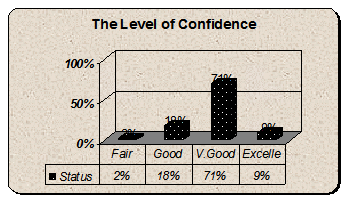
Fig. Graph of response on levels of confidence
Analysis: The levels of confidence on superiors are very satisfactory in Texeurop (BD) Ltd.
- How much tolerant your superior is?
Table 4.11 Response on levels of tolerance
| Status | Managerial | % | Skilled Labor | % | Unskilled | % | Others | % |
| Poor | ||||||||
| Fair | 5 | 17% | ||||||
| Good | 7 | 24% | 10 | 48% | ||||
| Very Good | 10 | 35% | 30 | 71% | 9 | 43% | 2 | 100% |
| Excellent | 7 | 24% | 12 | 29% | 2 | 9% | ||
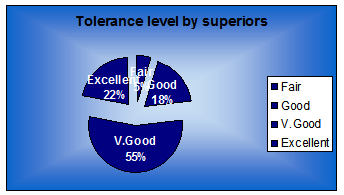
Fig. Graph of response on levels of tolerance
Analysis: The levels of tolerance by superiors are also at satisfactory level.
- Do you feel enthusiastic to take any responsibility other than those assigned on you?
Table 4.12 Response on level of enthusiasm
| Status | Managerial | % | Skilled Labor | % | Unskilled | % | Others | % |
| Less enthusiastic | ||||||||
| Enthusiastic | 14 | 48% | 28 | 67% | 7 | 33% | ||
| Very enthusiastic | 15 | 52% | 14 | 33% | 14 | 67% | 2 | 100% |
Analysis: In Texeurop (BD) Ltd the employees are highly enthusiastic to consider responsibilities other than those assigned on them.
- Do you hesitate to go to your superior in case of any problem?
Table 4.13 Response on hesitation to go to superiors
| Status | Managerial | % | Skilled Labor | % | Unskilled | % | Others | % |
| Yes | ||||||||
| No | 29 | 100% | 42 | 100% | 21 | 100% | 2 | 100% |
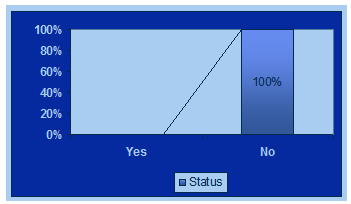
Fig. Graph of response on hesitation to go to superiors
Analysis: 100% of employees do not hesitate to go to superiors in case of any problem.
- The methods of appraising the job in relation to other jobs in the company.
Table 4.14 Response on current method of appraising the job
| Status | Managerial | % | Skilled Labor | % | Unskilled | % | Others | % |
| Poor | ||||||||
| Fair | 5 | 17% | ||||||
| Good | 8 | 28% | 21 | 50% | 11 | 52% | 1 | 50% |
| Very Good | 10 | 34% | 11 | 26% | 10 | 48% | 1 | 50% |
| Excellent | 6 | 21% | 10 | 24% | ||||

Fig. Graph of response on current method of appraising the job
Analysis: The majority portions in the both sides welcome the current method of appraising the job.
- The level of recognition you have, after you have completed a job.
Table 4.15 Response on level of recognition
| Status | Managerial | % | Skilled Labor | % | Unskilled | % | Others | % |
| Poor | ||||||||
| Fair | 3 | 7% | ||||||
| 9 | 31% | 5 | 12% | 4 | 19% | 2 | 100% | |
| Very Good | 15 | 52% | 37 | 88% | 17 | 81% | ||
| Excellent | 2 | 7% | ||||||

Fig. Graph of response on level of recognition
Analysis: The majority portions of both sides are satisfied on the level of recognition.
- Do you think the remuneration packages offered by Texeurop (BD) Ltd is adequate?
Table 4.16 Response on remuneration package
| Status | Managerial | % | Skilled Labor | % | Unskilled | % | Others | % |
| Poor | ||||||||
| Fair | 14 | 48% | 31 | 74% | 16 | 76% | 1 | 50% |
| Good | 10 | 35% | 11 | 26% | 5 | 24% | 1 | 50% |
| Very Good | 5 | 17% | ||||||
| Excellent | ||||||||
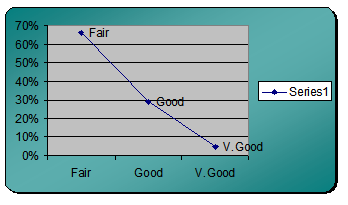
Fig. Graph of response on remuneration package
Analysis: Majority employees in the both side are not highly satisfied on remuneration package offer by Texeurop (BD) Ltd.
- Do you think the reward is presenting your performance?
Table 4.17 Response on reward
| Status | Managerial | % | Skilled Labor | % | Unskilled | % | Others | % |
| Poor | 16 | 55% | 18 | 43% | 7 | 33% | ||
| Fair | 10 | 35% | 20 | 48% | 14 | 66% | 2 | 100% |
| Good | 3 | 10% | 4 | 9% | ||||
| Very Good | ||||||||
| Excellent | ||||||||
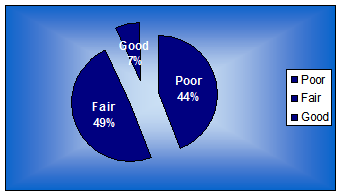
Fig. Graph of response on reward
Analysis: Majority portion of employees in the both side are not satisfied on the level of reward given by the organization
- Does working in Texeurop (BD) Ltd expresses a symbol of status on your part?
Table 4.18 Response on symbol of status
| Status | Managerial | % | Skilled Labor | % | Unskilled | % | Others | % |
| Yes | 21 | 72% | 42 | 100% | 21 | 100% | 2 | 100% |
| No | 8 | 28% | ||||||
Analysis: Majority of the employees stated that working in Texeurop (BD) Ltd expresses a symbol of status on their part.
- Do you believe the existing promotion policy is executed fairly?
Table 4.19 Response on existing promotion policy
| Status | Managerial | % | Skilled Labor | % | Unskilled | % | Others | % |
| Yes | 23 | 79% | 42 | 100% | 21% | 2% | ||
| No | 6 | 21% | ||||||
Analysis: Only 21% are dissatisfied in the management level. They expressed that after a certain level promotion is totally blocked. So, they are depressed.
- In case of promotion, what should be given priority?
Table 4.20 Response on priority of promotion
| Status | Managerial | % | Skilled Labor | % | Unskilled | % | Others | % |
| Merit | ||||||||
| Performance | ||||||||
| Seniority | ||||||||
| All | 29 | 100% | 42 | 100% | 21 | 100% | 2 | 100% |
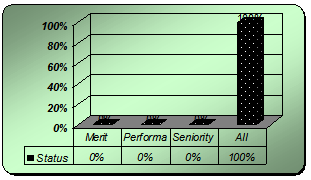
Fig. Graph of response on priority of promotion
Analysis: 100% of employees in the both side marked on “All”.
- How much secured you are with your job?
Table 4.21 Response on job security
| Status | Managerial | % | Skilled Labor | % | Unskilled | % | Others | % |
| Poor | ||||||||
| Fair | ||||||||
| Good | ||||||||
| Very Good | 11 | 38% | 12 | 29% | ||||
| Excellent | 18 | 62% | 30 | 71% | 21 | 100% | 2 | 100% |

Fig. Graph of response on job security
Analysis: Almost all employees in the both side feel highly secured with their job.
- Which kind of training methods do you prefer?
Table 4.22 Response on training methods
| Status | Managerial | % | Skilled Labor | % | Unskilled | % | Others | % |
| On the job | 35 | 83% | 21 | 100% | 2 | 100% | ||
| Off the job | ||||||||
| Training by experienced supervisor | 7 | 17% | ||||||
| Apprenticeship training | 29 | 100% | ||||||
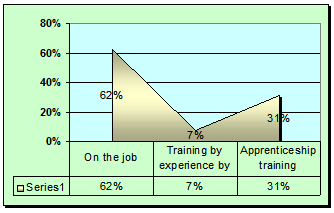
Fig. Graph of response on training methods
Analysis: 100% management supported to “Apprentice Training”. On the other hand 35% skilled labor, 100% unskilled and 100% other agreed to “on the job training”.
- Do you think the measures taken by the management, for your personal growth, adequate?
Table 4.23 Response on personal growth
| Status | Managerial | % | Skilled Labor | % | Unskilled | % | Others | % |
| Poor | ||||||||
| Fair | 7 | 24% | ||||||
| Good | 8 | 28% | 8 | 19% | 6 | 29% | ||
| Very Good | 14 | 48% | 34 | 81% | 15 | 71% | 2 | 100% |
| Excellent | ||||||||
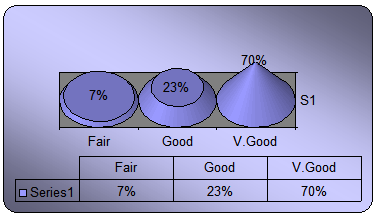
Fig. Graph of response on personal growth
Analysis: Most of the employees in the both side agreed that their organization is doing something for their personal growth.
- Any other comment you would like to make.
Table 4.24 Response on other comments
| Demand | No. of Reply |
| Increase of salary | 60 |
| Financial and social support | 65 |
| More evaluation by management | 60 |
| Fair Promotion | 25 |
| Improvement of Dinning | 85 |
| Transportation facilities | 50 |
| Increase facilities | 75 |
| Benefits after termination | 78 |
| Present management style is very good | 66 |
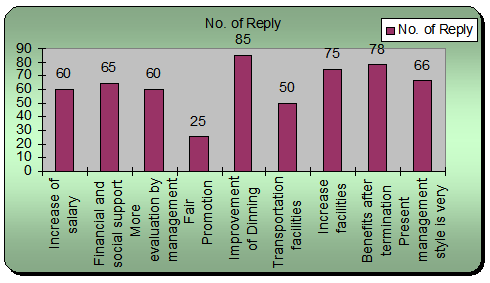
Fig. Graph of response on other comments
CONCLUSIONS & RECOMMENDATIONS
Conclusions:
Texeurop (BD) Ltd is one of the largest 100% export oriented garment industry in Bangladesh. It established in 2004. Within short time it has positioned itself as one of the best productive organization in the field of national economy. Texeurop (BD) Ltd have been in the RMG manufacturing business for 7 years, and can lay claim to be a market leader and trendsetter in this industry in Bangladesh. Throughout the decade of existence Texeurop (BD) Ltd concentrated on specializing in the production of a single item, the RMG, and created our own niche in the market.
It encompasses the successful continuation of the garments industry of Bangladesh in the post-MFA era, when free market will reign and demographic restraints and preferential treatment will become obsolete. Texeurop (BD) Ltd post MFA strategy is based on quality and reliability supported by large production capacities, backward linkage, professional management, refined technology, and market-oriented value-added basics.
Texeurop (BD) Ltd provides very friendly working environment free from political, bureaucratic and union interference which is contributing to the growth of Texeurop (BD) Ltd. Recently declared benefits increased the moral of the workforce and the workforce is highly motivated.
Quality control by temporary labor can not ensure the quality of the finished product properly To maintain the quality of the product highly skilled and professional quality control team is very important.
Research and .Development department did not yet start its function properly which is one of the main objective of Texeurop (BD) Ltd. Texeurop (BD) Ltd is an asset and highly potential business organization to contribute to national economy.
Recommendations:
The following recommendation should be taken into account for benefit of the company:
1. Texeurop (BD) Ltd should concentrate more for fixing a reasonable time for the employees in the management level.
2. Texeurop (BD) Ltd should think more for the development of existing work force.
3. Facilities to the employees should be increased in every aspect.
4. Texeurop (BD) Ltd should concentrate more for establishing strong morale of 100% unskilled workers. In this respect company can formulate different types of training program and communication process for the unskilled workforce.
5. Remuneration packages should be made attractive for the both side of the work force.
6. Extrinsic rewards such as monetary benefits should be formulated to motivate the employees in the both sides. Company should concentrate more in this regard because majority of employees are not satisfied on this.
7. Company can organize new opportunities or make diversification in it’s activities to formulate promotion which is totally blocked after the post of assistant general manager.
8. Management should be made an effective training process by concentrating more with the attitudes and activities of the workers.
- Improvement of dinning, benefits after termination and others should be increased more for effective motivations.
- Texeurop (BD) Ltd should concentrate more for R& D in order to sustain in the competitive market.
REFERENCES:
1. Griffin, W. (2008) .Management. Boston. Houghton Mifflin
2. Delaney, J. T., M. A. Huselid. (1996). The impact of human resource management practices on perceptions of organizational performance. Academy of Management Journal 39 (4) 949-969.
3. Fisher, C. D., E. A. Locke. (1992). The New Look in Job Satisfaction Research and Theory. P. C. S. CJ. Cranny, Eugene F. Stone., eds. Job Satisfaction: How People Feel About Their Jobs and How It Affects Their Performance. Lexington Books, New York,
4. Iaffaldano, M. T. P. M. Muchinsky. (1985). Job satisfaction and job performance: A meta-analysis. Psychological Bulletin 97 (2) 251-273.
5. Silvestro, R., S. Cross. (2000). Applying the service-profit chain in a retail environment: Challenging the satisfaction mirror. International Journal of Service Industry Management 11 (3) 244-268.
Some are parts:
Human Resource Management Practices Texeurop BD Ltd (Part 1)
Human Resource Management Practices Texeurop BD Ltd (Part 2)












